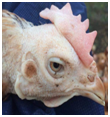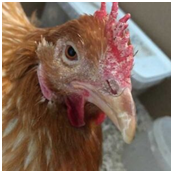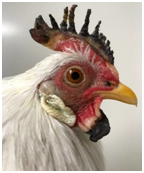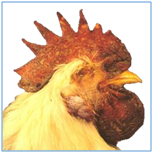The comb is an indication of chicken’s health. A comb is a fleshy growth or crest on the top of the head of gallinaceous birds, such as turkeys, pheasants, and domestic chickens. It is an outgrowth from the dermal and epidermal layers of skin of the head. They also have two thin, fleshy growths hanging down below their bill called a “wattle.” The comb is larger in the males than in the females. It is pleasant to see the cock walking with upright head with comb which is an ornamental majesty of the bird, it is crown adored by the originator the God. It is also an indication of good laying bird. Although the comb primarily is for display, but it also serves radiator in cooling the bird in hot weather. Often we ignore the importance of comb and wattles of poultry. A healthy comb will be firm and rubbery to the touch and a bright even colour with no marks or discolouration.
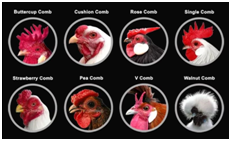
What are the types combs in chicken?
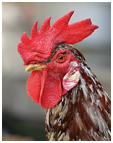
Types of combs, include single, rose, pea, cushion, strawberry, buttercup, and V-shaped (See the image) Various colour, shape and size depending on the breeds.
| COMB TYPE | CHARACTERISTICS |
| Single | Single, smooth, soft comb beginning at beak – back of head. Contains about 6 fleshy ridges. |
| Pea | Low, medium sized comb with 3ridges from top of beak – top of head. Center ridge is slightly raised with pea-like protrusions. |
| Walnut | Medium sized, solid comb. Combination of both Rose and Pea Comb. Resembles a walnut. |
| V-Shaped | V-shaped. Two solid, thick points at base of beak. Looks like horns. |
| Buttercup | Has a very short single comb down the center with two larger combs on either side. |
| Carnation | Single comb with several lobes in the back. |
| Rose | Flat and close to the head. Runs from beak to back of head. Front 2/3 covered in round bumps, similar to a rose. Back end comes to a point. |
| Cushion | Round, small, smooth comb without any ridges or points. Runs from top of beak –only short way up head. |
| Strawberry | Similar to Rose, but are not as flat and does not form a point. Looks like a strawberry. |
What is the function of the comb on chickens?
The Comb of a chicken functions as its cooling system. Chickens do not sweat like humans. The chicken cools itself by circulating its blood throughout its comb and wattles. The comb in ascent operates like the radiator in a car. When the weather is hot, blood circulates through the tiny capillaries inside the comb and wattle, thus cooling the chicken down. When blood runs through the comb and wattle, heat is easily transfers to the outside air. So, blood running through its comb and wattle is like having its own built in air conditioner. The comb is an indicator of a chicken’s health, too, and it helps initiate the mating process.
What comb indicates?
- The bright comb in laying hen indicates the good health of the bird.
- A pale but plump comb is likely to mean the hen is healthy but off lay.
- A dry, shriveled or flaky comb may be an indicator of poor health (Figure 1)
- A comb with a blueish tinge, purple colouring or dark tips may indicate a circulatory problem.
- An adult hen with a tiny comb may indicate the hen has a serious health issue.
- Greyish white spots on the comb can be caused by fungal conditions.
- Nodules on the comb may be a symptom of fowl pox.
What does the colour of comb indicate?
Red comb: A chicken with an extremely bright red comb and wattle has a lot of blood circulating throughout it indicates healthy comb.
Pale comb: An unhealthy comb will be very pale or discoloured, or have white patches of flaking skin. Black Combs are a sign of frostbite, purple combs are a sign of circulation problems and blistering could be either disease, insect bites or sunburn. It also shows that the bird is stressed, parasitic infested, molting or just laid an egg.
A white comb indicates a chicken that has internal bleeding, anaemia or a heavy parasite infestation. The white means the blood has stopped flowing to the comb and it can be a sign of impending death.
A pink comb is not normally a symptom that something is wrong unless it is accompanied by swelling, discharge or smell. A pink comb is a sign the hen has not started to lay eggs or has stopped laying for the moult.
A black chickens comb is normal for black chickens like the Kadaklnath. Chickens developing a black comb are likely to be suffering from frostbite. The black parts of the comb will shrivel up and drop off. Chickens are remarkably resilient to injuries of this type.
A comb turning black in summer is probably sun burn if the bird is otherwise healthy. A black and swollen comb may be the sign of a snake bite.
Frostbite comb become dark, but the chickens normally recover well as long as they are left alone and not pecked at by other chickens. Frostbite rarely bleeds, it starts off white, changes rapidly to a yellow and then black and begins to slough away.
A blue comb in chickens is a sign that there is a circulation issue or lung problem, the blue colour comes from the blood not being oxygenated properly.A blue comb in chickens means the bird is getting enough oxygen to survive for long.
A purple comb in chickens is the advanced stage of Cyanosis. It can indicate a problem with the heart, lungs or liver of the bird.
Purple comb at the tips: is not normally anything to worry about unless it spreads. This slight discolouration at the comb tips can happen to both hens and cockerels in sunshine in summer and in young cockerels in the prime of their life. Broody hens, when they stop laying the comb goes a little paler and droops over to one side.
A chicken’s comb may be dry for a few reasons, a simple change in the weather, parasites or nutritional deficiencies.
Common diseases that affect comb and wattles
Looking in to the face and comb we can judge that the bird is sick or not. The following diseases express the illness through comb colour.
1.Pullet disease, (Blue comb, Avian Monocytosis)
Blue comb or pullet disease of chickens is most often seen in birds from 15 to 25 weeks of age. A large portion of an apparently healthy flock develops a sudden affliction which is characterized by a lack of appetite, listlessness, sudden deaths, often some diarrhea, a sharp drop in production in laying birds and darkening of the comb ( hence the name “blue `comb “) in a few of the affected birds. A mortality of 0-50%. It is associated with hot weather, water deprivation, toxin and possibly a virus infection.
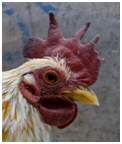
Clinical signs: comprised of depression, Loss of appetite, crop distension, dark comb and wattles, watery diarrhoea, dehydration and drop in egg production.
Fig 3. Blue or purple colour comb
Post-mortem lesions: dehydration, skin cyanosis of head, Skeletal muscle necrosis, crop distended, catarrhal enteritis, mucoid casts in intestine, liver swollen with foci. Swollen kidneys and Pancreas chalky.
Treatment: Adequate water supply, antibiotics, molasses, multivitamins in water.
Prevention: Good management, hygiene, diet and water supply.
A purplish comb signals a lack of oxygen in the blood, poor circulation or respiratory/breathing issues. Some obstruction caught in the throat and lack of oxygen.
2.Avian Influenza (AI)
Several strains of avian influenza are mild and go away without complications; but one is generally fatal. It has to be controlled quickly. Symptoms of the stronger strain include facial swelling, dehydration, respiratory distress, and blue comb and wattles. Infected birds may present red spots on their legs and combs, and bloody discharge from their nostrils. Eggs may be soft or shell-less as well.
Avian influenza is highly transmittable; it can be transferred via shoes, rodents and improper disposal of dead birds and their waste. Suspected cases must be reported to the state veterinary oversight office; all exposed birds must be euthanized to prevent the spread of the illness.
3. Fowl Pox
Fowl pox is a viral disease that can infect birds of any age. It spreads slowly through direct contact with an infected bird or via mosquitoes. The dry type of fowl pox presents nodules — which eventually turn into scabs– on wattles, comb, ears and eyes. Wet pox presents in the mouth and respiratory system, causing difficulty eating and breathing. Fowl pox takes three to five weeks to run its course. The prognosis for recovery is generally good. Complications of both types of pox include growth retardation and decreased egg laying. Vaccination is the only way to prevent the occurrence of fowl pox; seek your vet’s input; he may suggest a first administration as early as 6 to 10 weeks of age
4. Fowl Cholera
Fowl cholera, caused by bacteria, Pasteurella multocida has symptoms that include wattle swelling, a purple color of the comb and wattle, diarrhea, coughing and oral discharge. Other symptoms that may occur are loss of appetite, swollen joints, fever, lameness and sudden death. It is treated with antibiotics, including penicillin, tetracyclin and erythromycin. But fowl cholera can recur when the use of antibiotics stops. The bacteria can stay in soil for long periods but can be controlled using disinfectants. Fowl cholera is most likely to occur in adult and adult birds; it strikes hens less often than cocks.
5. Blackhead Disease
Blackhead disease, or histomoniasis, primarily infects turkeys but has been seen in chickens. Chickens are better able to resist the worst effects of blackhead disease, but they carry the protozoa and pass them to other fowl. Histomoniasis is transmitted by the larvae of the cecal worm but can also be obtained when a fowl eats earthworms that have ingested cecal worm eggs. Histomoniasis can also be transmitted via the feces of other infected birds.
Symptoms of blackhead disease include lack of appetite, weight loss, ruffled feathers and a sleepy appearance. Yellow droppings are another sign of histomoniasis infection. Histomoniasis can be fatal untreated; adding dimetridazole to drinking water or feed will stop the infection.
Birds with symptoms must be quarantined; any birds who die from the disease should be burned.
Prevent or at least limit blackhead disease by disinfecting thoroughly, to discourage buildup of the disease-causing organisms.

6. Bacterial diseases: Colibacillosis (Coliform infections) loss of appetite, increased thirst and a pale, anemic appearance of comb and wattles.
Infection with Staphylococcus and pasturella spp. Cause necrosis of the comb, histopathologic ally, liquefactive necrosis of epidermal epithelial cells with hyperplasia, vesicle formation in the epidermis, congestion and Haemorrhages and fibrinous thrombi of underlying dermis in the comb, the epidermis with eosinophilic necrosis.
Clinical signs: scaly, white crusty circular patches or lighter diffuse areas on the comb. Ulcers often covered with dark scabs.
7. Mycotic Infections:
The comb is vulnerable to invasion of several fungal agents resulting in causation of primary infection, but often complicated by secondary bacterial infections.
Favus (Ring worm), it is also called as Dermatophytosis,or Avian Ringworm
Favus is a fungal skin infection caused by a group of zoophilic fungi called dermatophytes. Microsporum gallinae, Lophophyton gallinae is the most common species isolated from cases of favus in chicken (Fig7).
Clinical signs : white powdery comb and wattles, thickened, crusty head. Histologically lesions included hyper keratosis of skin epithelium with invasion of the stratum cornrum by fungal mycelia, acanthosis and hydropic degeneration of cells in the stratum spinosum.
Treatment : Antifungal agents such as Miconazole 2 % apply twice daily or povidone iodine apply once daily.
Cutaneous Candidiasis: A fungal infection caused by Candida albicans, resuling in crusty white circular patches or lighter diffuse areas on the comb. Some birds may have scabs within lesions.
Epidermoid cysts: these may appear on the comb or wattles.They appear as firm, yellow nodules, keratinized masses measuring 4-15 mm in diameter. They may be infected with Aspergillosisfumigatus and Alternaria spp.
Parasitic infestation:
Sometimes the parasites are more visible, especially when they cluster around the hen’s comb, like sticktight fleas (See the fig 8).
| Sl. No | COMB AND WATTLE SIGNS | WHAT IT MEANS |
| 1 | Red, rosy comb and wattle | happy, healthy, sexually mature chicken |
| 2 | Extremely red comb and wattle | your chicken is hot |
| 3 | Pale comb and wattle | not sexually active or mature |
| 4 | Pale comb and wattle | is suffering from heat exhaustion |
| 5 | Pale comb and wattle | chicken is stressed |
| 6 | Pale comb and wattle or turning white | chicken is molting |
| 7 | Pale comb and wattle | chicken is dehydrated |
| 8 | Pale comb and wattle | chicken is under stress |
| 9 | Pale comb and wattle | chicken is suffering from parasites |
| 10 | Pale comb and wattle | chicken is ill |
| 11 | Black spots on comb and wattle | chicken is suffering from frostbite |
| 12 | Black spots on comb and wattle | fowl pox |
| 13 | Black spots on comb and wattle | chicken may be being pecked at by flock mates |
| 14 | Purple or extreme red comb and wattle | chicken may be choking |
| 15 | Purple or extreme red comb and wattle | chicken may behaving a heart attack |
| 16 | Purple or extreme red comb and wattle | chicken may behaving a stroke |
| 17 | Floppy comb on hen | dehydrated |
| 18 | Floppy comb | just laid an egg |
| 19 | Floppy comb | sign of broody hen |
| 20 | loppy comb | sign of an old chicken |
| 21 | missing parts on comb and wattle | chicken is being bullied or pecked at by flock mates |
When chicken is under stress, the comb or wattle become pale can also indicate that chicken is stressed for some reason. This can be due to multiple reasons as listed in the table: 2. Floppy combs, pale combs and wattles. Over crowd, some unusual disturbance, entry of un known person, animal, dog, snake etc. injury, insect infestation and extreme heat or cold , nutritional deficiencies are all cause pale comb.
Why the comb turning white? It indicates that the chicken is molting, it is very common for their comb and wattle to turn pale in color. Molting is when a chicken loses its old feathers to grow in a new set of full, fluffy feathers to better insulate them during the upcoming cold weather.
When a chicken is molting, it puts most of its energy into growing new feathers. It is hard work growing new feathers! This is also why most laying hens stop laying during a molt.
A chicken comb turning white or a pale chicken comb and wattle can also signify it is dehydrated, stressed, suffering from parasites or is ill.
Conclusion:
Changes in the chickens comb and wattle can tell many things about them, including their health, sexual maturity and wellbeing. Daily take time to observe the face and comb of the flock so that you can notice any problems that may be going on.
The appearance of hens or roosters comb and wattle is their way of telling how they are doing. Observe to what they are appearing and if there is something going on, take care of it as soon as possible.
Acknowledgement: The author thanks Google for details and Images.
